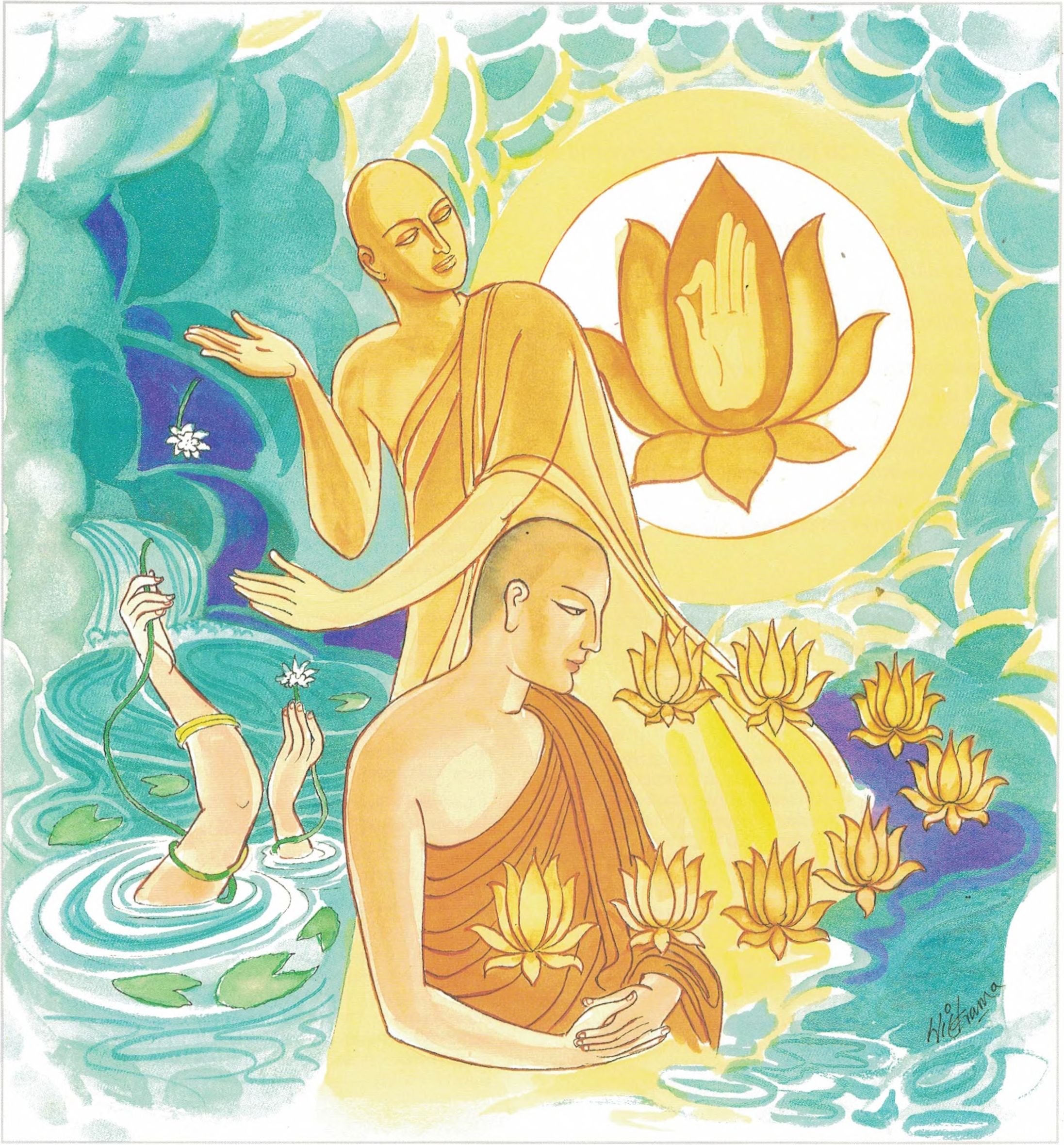Dhammapada (Illustrated)
by Ven. Weagoda Sarada Maha Thero | 1993 | 341,201 words | ISBN-10: 9810049382 | ISBN-13: 9789810049386
This page describes The Story of a Venerable who had been a Goldsmith which is verse 285 of the English translation of the Dhammapada which forms a part of the Sutta Pitaka of the Buddhist canon of literature. Presenting the fundamental basics of the Buddhist way of life, the Dhammapada is a collection of 423 stanzas. This verse 285 is part of the Magga Vagga (The Path) and the moral of the story is “Cut Down The Forest, No Single Tree.’Tis The Forest That Begets Fear. Be Ye Freed Of That”.
Verse 285 - The Story of a Venerable who had been a Goldsmith
Pali text, illustration and English translation of Dhammapada verse 285:
ucchinda sinehamattano kumudaṃ sāradikaṃ'va pāṇinā |
santimaggameva brūhaya nibbāṇaṃ sugatena desitaṃ || 285 ||
285. Cut off affection for oneself as hand a lily in the Fall. Cultivate this peaceful path, Nibbāna by the Buddha taught.
 Cut off passions, like breaking a lily with one’s hand. Pursue the path of peace to Nibbāna. |
The Story of a Venerable who had been a Goldsmith
While residing at the Jetavana Monastery, the Buddha spoke this verse with reference to a monk, a pupil of Venerable Sāriputta.
Once, a young, handsome son of a goldsmith was admitted into the Sangha by Venerable Sāriputta. The young monk was given loathsomeness of the dead body as the meditation topic by Venerable Sāriputta. After taking the meditation topic he left for the forest and practiced meditation there; but he made very little progress. So he returned twice to Venerable Sāriputta for further instructions. Still, he made no progress. So Venerable Sāriputta took the young monk to the Buddha, and related everything about the young monk.
The Buddha knew that the young monk was the son of a goldsmith, and also that he had been born in the family of goldsmiths during his past five hundred existences. Therefore the Buddha changed the subject of meditation for the young monk; instead of loathsomeness, he was instructed to meditate on pleasantness. With his supernormal power, the Buddha created a beautiful lotus flower as big as a cart-wheel and told the young monk to stick it on the mound of sand just outside the monastery. The young monk, concentrating on the big, beautiful, fragrant lotus flower, was able to get rid of the hindrances. He was filled with delightful satisfaction (pīti), and step by step he progressed until he reached as far as the fourth level of mental absorption (jhāna).
The Buddha saw him from his perfumed chamber and with his supernormal power made the flower wither instantly. Seeing the flower wither and change its colour, the monk perceived the impermanent nature of the flower and of all other things and beings. That led to the realization of the impermanence, unsatisfactoriness and the insubstantiality of all conditioned things. At that instant, the Buddha sent forth his radiance and appeared as if in person to the young monk and instructed him to get rid of craving (taṇhā). At the end of the discourse, the young monk attained arahatship.
Explanatory Translation (Verse 285)
sāradikaṃ kumudaṃ pāṇinā iva attano sineham ucchinda
santimaggam eva brūhaya nibbānaṃ sugatena desitaṃ
sāradikaṃ [sāradika]: in the autumn; kumudaṃ [kumuda]: a lily; pāṇinā iva: like (plucking) with one’s own hand; attano sineham: attachment to self, ucchinda: pluck out; santimaggam eva: the path only to Nibbāna; brūhaya nibbānaṃ [nibbāna]: cultivate; sugatena: by the Buddha; desitaṃ [desita]: has been preached
Just like a person plucking out a lily with one’s own hand, pluck out your self-attachment. Cultivate the path to Nibbāna, as advocated by the Buddha.
Commentary and exegetical material (Verse 286)
kumudaṃ: lily flower. In this image the plucking of the lily flower by hand is used to emphasize the ease with which the young monk attained arahatship. Here, the object of contemplation was a lotus. This was the object given to him for meditation. In meditation the use of such an object (kasiṇa) was a wide-spread practice in the Buddhist system of mind training.
attano: According to the stanza here, it means the five aggregates. The five aggregates, namely, are: matter (rūpakkhandha); sensations (vedanākkhandha);perceptions (Saññākkhandha); mental formations (samkhārakkhandha) and consciousness (viññānakkhandha).
These, namely, are the five aggregates. What we call a being, or an individual, or I, is only a convenient name or a label given to the combination of these five groups. They are all impermanent, all constantly changing. Whatever is impermanent is dukkha (yad aniccaṃ tam dukkhaṃ). This is the true meaning of the Buddha’s words: In brief the five aggregates of attachment are dukkha. They are not the same for two consecutive moments.
